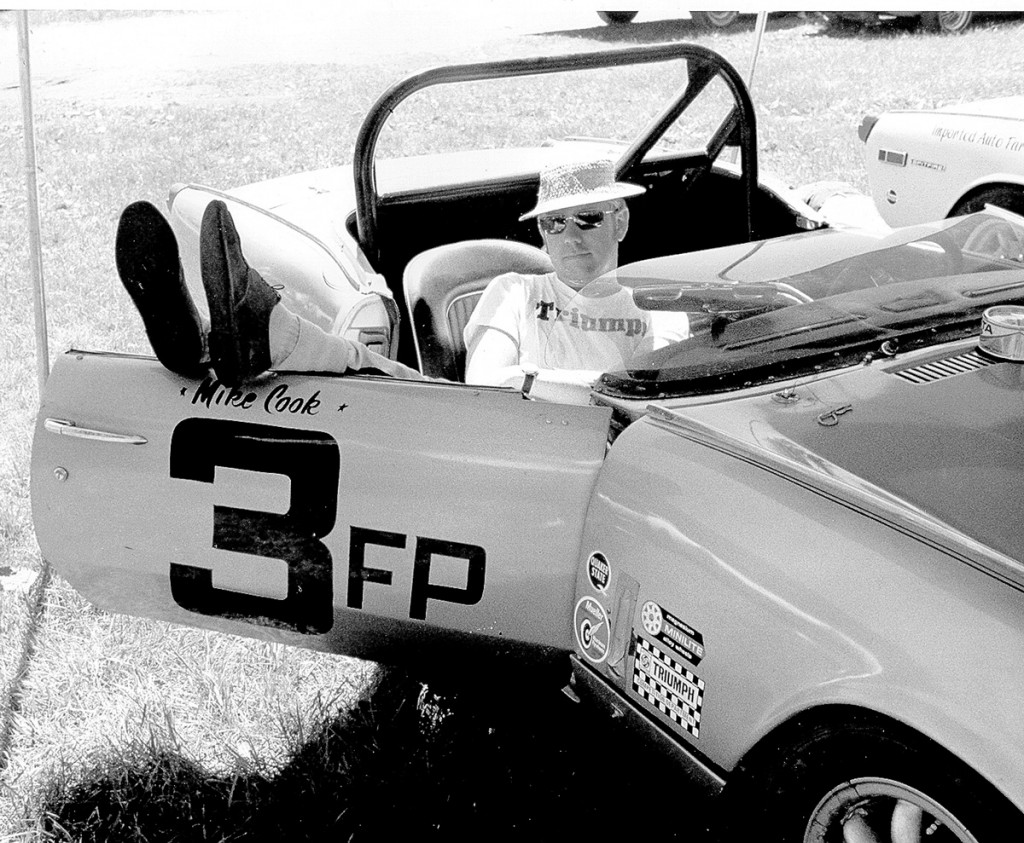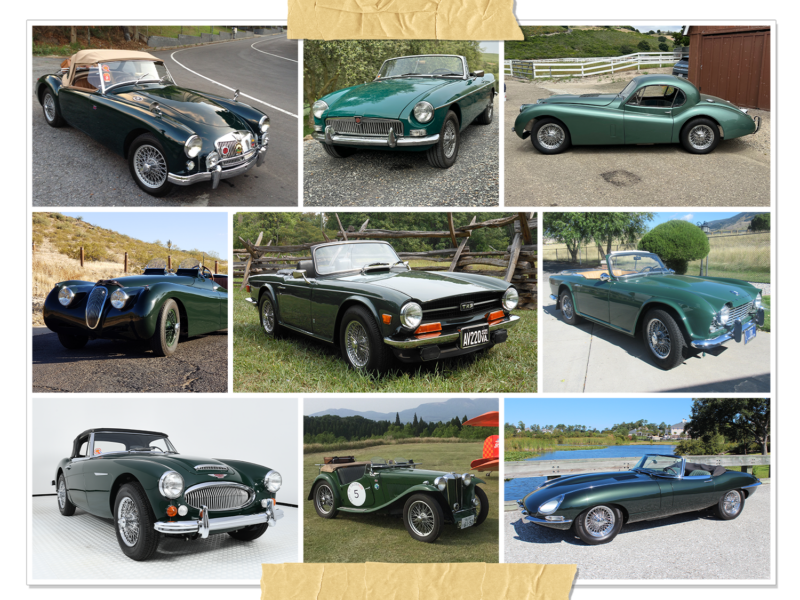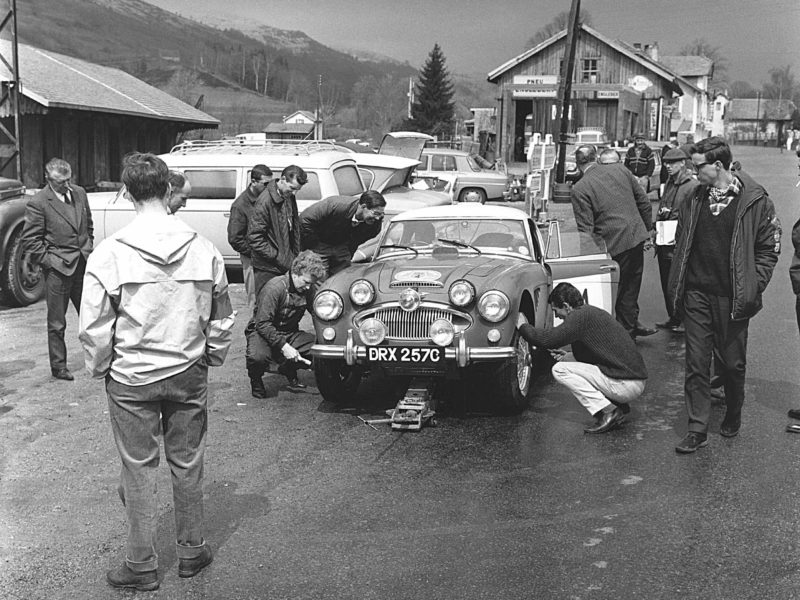
While Mike Cook raced this Spitfire Mk 3 for several years, he also used it to catch some relaxing moments off track, as shown here at Lime Rock in 1971. Mike purchased the car from the Triumph Competition Department after Lee Mueller drove it to a win at the 1969 SCCA FP championship.
For more than 30 years, Mike Cook’s job was to publicize and promote British cars in America. From the height of the sports car craze in the late ’50s to the end of the era when Jaguar ownership passed to Ford, Cook helped create the image of the marques, generate media buzz, launch new models, and publicize racing successes.
He was at the heart of the marketing effort to make Americans fall in love with British cars and turn them into loyal enthusiasts. And it was a resounding success.
How did Cook get to this point? It began in 1958 when he was fresh out of college. He sold his first British car, a 1955 Triumph TR2, in order to buy a plane ticket from Ohio to New York City, where he hoped to land an advertising job. Standard-Triumph hired him as assistant advertising manager and secretary of the Triumph Sports Owners Association.
“In the late ’50s, sports car mania was sweeping the country,” says Cook. “Enthusiasm for Triumphs, MGs, Sunbeams and Jaguars was terrific, and I was enthused to be part of it all.”
Cook eventually moved up to become advertising and public relations manager for Triumph in America. He left for a one-year stint at Mobil Oil, but returned in 1968 as the corporate public relations manager for British Leyland, promoting famous marques Triumph, MG, Jaguar, Rover and Land Rover. After this company met its demise, he became the product publicity manager for Jaguar in 1982. Cook touted Jaguars for nearly a decade until the company passed to Ford, and then he decided to pursue freelance writing on automotive subjects. What a career ride.
The focus of Cook’s work was promoting the vehicles themselves, but he also got involved in the spin for the foundering British Leyland corporation. “Although there was a sound, profitable organization in North America, the British Leyland parent company was hopeless, badly managed and underfinanced,” says Cook.
“My biggest challenge was trying to keep up customer enthusiasm and loyalty in the face of product quality problems,” Cook explains. “It wasn’t a challenge to sell the cars—we were selling 30,000 MGBs per year 15 years after it went into production with virtually no changes. But there was always a fine line between selling cars and then backing it up.”
Publicizing racing results was the most interesting and enjoyable aspect of the job, according to Cook. In addition to factory racing efforts, the company had a huge support program for SCCA racing, offering prize money for every class that featured a British Leyland car.

This shot captures Mike Cook (left) and Jaguar Corporate Communications Director David Boole with a disguised Jaguar XJ40 sedan. The two were setting up a test route around Tucson, Arizona, for the 1987 debut of the new car.
The stakes were highest when launching new car models. One of Cook’s first launches was the Triumph Herald. Introduced in 1960, marketing for the car emphasized that it was easy to repair. For the demonstration, the car was unveiled as a chassis with engine, transmission and wheels, surrounded by components in seven large sections, he explains.
A team of four Triumph employees, including Cook, took just two minutes and 25 seconds to assemble the car on stage and close the hood. The company president got in, fired it up and drove it around the stage, demonstrating the 24-foot turning radius.
The TR6 didn’t get a press introduction because they decided it didn’t need it. “The TR6 generated publicity out of thin air,” says Cook.
However, the TR7 needed a launch because it was a departure from the old sports car style, says Cook. “The company sent us 35 cars for the world premiere, and we managed to get 17 of them to run right. Some were missing pieces like rear view mirrors. The car got good press considering its unusual looks.”
But the test cars for the magazine editors didn’t go as well. The car given to the AutoWeek editor blew its engine, while the editor for Sports Car Graphic rolled his car in a snowstorm.
Cook’s last new model launch was the Jaguar XJ40, introduced in 1987 as a 1988 model. “I made seven trips to Tucson to get that blowout organized, but it was worth it. We got excellent coverage,” he says.
One of the benefits of working for a car company was the company cars, says Cook. “We got to drive whatever we were overstocked on that year,” he says. Although he piloted an MGB for a short time, Cook mostly drove Triumphs. He proudly proclaims that he’s had every model in the Triumph line as a daily driver at some point in his life—except for the TR250, which was provided the year he worked at Mobil Oil. His wife had Spitfires as her daily drivers.
With so much exposure to cars and racers, it was only a matter of time before Cook got a taste of the track. He raced a 1960 TR3 for five years in SCCA regional and national competition, then raced a 1969 Spitfire for three years. He ran a TR7 in the 24 Hours of Nelson Ledges and a 1980 TR8 at the 12 Hours of Road Atlanta, as well as some Showroom Stock Enduro races.
Since Cook left Jaguar in 1991, his life has continued on the fast track. He has published three books, “The Triumph Spitfire,” “The Illustrated Jaguar Buyers Guide” and “Triumph Cars in America.” He also updated “Jaguar in America” by John Dugdale. He edits two magazines, Jaguar Journal, a bimonthly publication for the members of Jaguar Clubs of North America, and The Vintage Triumph, a quarterly publication for the members of Vintage Triumph Register. Plus, he writes a monthly column on a variety of automotive topics for Hemmings’ Sport & Exotic Car.
Cook was also instrumental in setting up the Jaguar North American Archives at the corporate facility in Mahwah, New Jersey. These archives contain the company papers, literature, photos, racing memorabilia, trophies, press clippings, heritage certificates, films, videos and other resources documenting British cars in America. It’s not a museum; rather, it’s a resource repository for research. Cook works in the archives two days a week, researching answers to historical questions.
A resident of Wayne, New Jersey, he spends what spare time he can find messing around with his 1980 Triumph Spitfire. “It needs odds and ends,” he adds.








'Mike Cook – British Car Promoter' have 3 comments
August 7, 2012 @ 8:20 am Roy Basett
Mike
Happened to stumble on the Moss article and to my enjoyment found your name. You may not remember me but at one time I reported to JRT as the North American Director for Leyland Tractors in Harrisburg PA.
During my time with Leyland I was given a TR 8 as my company car, I fell in love with it and purchased “the eight” from JRT who replaced it with Jaguars.
Unfortunate circumstances forced me to sell it to a garage owning friend on the premise that one day I will buy it back. Well after 26 years I repurchased “the eight” and my original title. You see, my friend never realy drove it and for some reason or another he kept it for me.
It now resides in my garage in Wisconsin and about to undergo a major rebuild.
I wish you the best in your retirement and the work you are involved in from the old days.
Kindest regards
Roy
May 16, 2013 @ 11:36 pm Mike Japp
I met Mr. Cook at Road Atlanta last year (April 2012) during the Mitty weekend and the Spitfire 50th anniversary. Before driving my Spitfire from Pensacola to the track, I learned he was going to be there so I brought my copy of his book, “Triumph Cars in America”. When he was signing autographs, I presented the book for him to sign. When he saw it, his face lit up in a big smile. Other fans were having him sign posters but I had one of his books, so that made him happy. The next day, myself and the Spitfire magazine owner spoke to him for a few minutes by the NASS display. I’m glad to have met Mr. Cook and have my picture with someone who contributed so much to Triumph’s history. My Spitfire was my first car and 32 years later I still enjoy it. Happy retirement, Mr. Cook, you’ve earned it!
November 28, 2018 @ 9:56 am Gary Hamilton
Sad news, I heard Mike passed away earlier this week.
I meet Mike back in 76- or 77 in Leonia, NJ when my friend and I took a ride out from LI in his TR3.
I remember pulling up to this very non assuming brick building; there was s row of what looked like TR7’s parked along the building, but upon further inspection you could see twin exhausts out back.
It was the Shape of things to come with the TR7, the TR8!
Hemmings did a nice piece on Mike a few years ago in Sports and Exotic magazine about his history with BL.
https://www.hemmings.com/magazine/hs…c/3749491.html